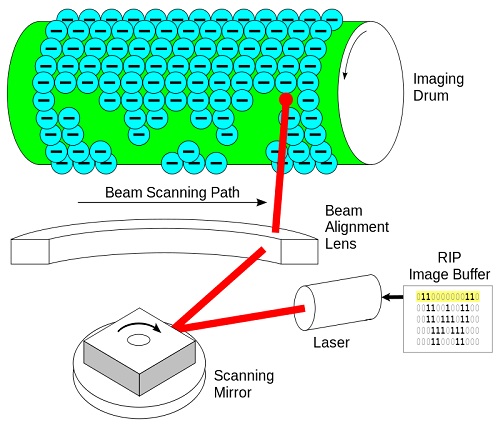A Guide to Understanding How Laserjet Printers Work
![]()
Printers have come a long way from the days when the perforated sides of each sheet printed had to be ripped off to ensure a clean document. However, with the great advancements in printing technology have come a diversity in the technology and selection of the printer products that are offered.
There are several different methods of printing available today, and there are many types of printers for any given printing method. Each has different benefits and drawbacks, so knowing a little bit about how laserjet printers work can be instrumental in picking the right model for use in an office, home, or commercial environment.
Every situation has its own ideal printing solution—from massive business spaces with hundreds of employees and thousands of pages to print a month, to small home offices where a printer is rarely used. This handy guide explores how laserjet printers work, the best uses for laserjet printers, and how to supply them with the right type and amount of toner.
An Affordable Printing Solution
Laserjet printing is considered to be one of the most affordable types of printing, from initial costs to long-term operation. In the early days, laserjet printing was more expensive due to the price of the components, like laser diodes. Owning a laserjet printer was uncommon for the average consumer; however, as costs of production have decreased, so have costs for printers. Now, laserjet printers are common in both large commercial settings and small home offices.
Laserjet printers are most affordable as monochromatic printers—printers that only print in black and white. Color printing with laserjet can be more expensive and may not be ideal for homes or small offices.
The great thing about how laserjet printers work is that the more you spend on an initial investment in a printer, the lower the operating costs. Larger machines generally print faster and more efficiently, making the printing process much cheaper. Even at the lower end on the price scale, laserjet printing is extremely affordable, often averaging $.06 per page or less.
The Mechanics of Laserjet Printers

Laserjet printing came about in the late 1960s and early 1970s as an answer to the existing form of inkjet printing. Instead of using liquid ink, like an inkjet printer, laserjet printers use a dry powder known as toner which is then heated and bonded to the page.
The exact process of how laserjet printers work is somewhat complicated, but the basics are as follows:
- First, the printer uses a laser to project an image of what is to be printed onto an electromagnetically charged drum.
- When the laser hits the drum, the areas where the light hits cause the ink powder to release from the drum and attach to the piece of paper.
- Similar to the static we experience from a balloon that is stuck to a shirt, the ink is attracted to the drum.
- The drum then rotates and presses the ink onto a sheet of paper, which runs through a heated section that melts the ink onto the paper.
How laserjet printers work may seem complicated, but the lack of moving parts makes them easy to maintain and reliable.
Comparing Laserjet Printers to Inkjet Printers
Since laserjet printers are so much less expensive than they were in the past, it’s common to see laserjet printers marketed for home or small office use right alongside inkjet printers. The cheapest inkjet printers may run slightly cheaper than the cheapest laserjet printers, but laserjet printers are still very affordable on the lower end of the price scale and perform well for most basic printing tasks. Printing lines of text is the laserjet printer’s strongest function and when used to print simple text documents, laserjet printers are the top choice.
The one area where inkjet printers tend to outshine laserjet printers is in rendering complex and saturated images. Because of how laserjet printers work, the dry toner powder doesn’t produce colors as deep as those created by an inkjet printer, and the colors it does produce can come out with streaks and bars on the image. The reason images are a problem for laserjet printers is due to its speed, which prevents it from completing an image before the drum rotates, and can harm the quality of the final image.
Laserjet printers, however, operate at a lower cost per page than most inkjet printers. Every printer takes a different ink or toner cartridge, but printing with an inkjet printer can cost three times as much as printing with laserjet. For most offices, this means that laserjet printing is a much better option for performing daily tasks at an inexpensive and reliable level.
Finding a Cheap, High-Quality Toner Supplier
Laserjet printers operate at a low cost, but finding the right source for toner can make having one even cheaper. Every printer requires its own unique cartridge, meaning the price depends on the vendor that sells the right one for a given printer. Luckily, there are other options besides buying the OEM cartridges at full price.
Remanufactured toner cartridges can be bought at 50% of the original price or even less. The best vendors for this type of cartridge test their cartridges and make sure they operate at optimal level—to OEM standards or better. Just like buying a refurbished laptop, this is an easy way to save a lot of money quickly. The difference between buying OEM and buying remanufactured is that over time, printing costs can really add up, so the more remanufactured toner cartridges you use, the higher the savings.
Check out the supply of toner cartridges for printers, like Samsung, Xerox, and Brother, at 1ink.com today and discover our wide selection of remanufactured toner cartridges.
If you enjoyed learning about laserjet printers, explore our blog to learn more about printers, ink and toner cartridges, and more.
